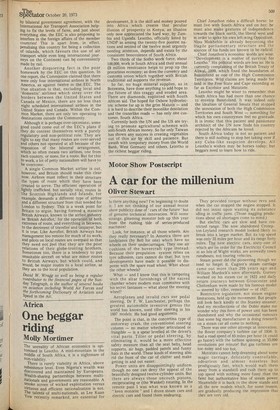Motor Show Postscript
A car for the millenium
Oliver Stewart
Is there anything new? I'm beginning to doubt it. I am not thinking of our annual motor show publicity dose of ' cars of the future' but of genuine technical innovation. Will some strange, gleaming monster bob up this year from the rushing tide of series-produced machines?
Look, for instance, at all those wheels. Are they really necessary? In America there are landplanes (by Bell for one) which have no wheels on their undercarriages. They use air cushions of the hovercraft type instead. Because their propulsion system relies on tyre adhesion, cars cannot do that; but tyre developments have made it possible to dispense with the spare road wheel. What about the other wheels?
What — and I know that this is tampering with the altar furnishings of the sacred chamber where modern man communes with his secret fantasies — what about the steering wheel?
Aeroplanes and invalid cars use pedal steering. Dr F. W. Lanchester, perhaps the greatest automobile inventive genius the world has known, used tiller steering in his 1897 models. He had good arguments.
The point is that, in the concertina type of motorway crash, the conventional steering column — no matter whether articulated or frangible — is a spear levelled at the driver's vital parts. Tiller or pedal steering, by eliminating it, would be a more effective safety measure than all the seat belts„ head supports, air bags, padded panels and funny hats in the world. These kinds of steering also rid the front of the car of clutter and make getting in and out easier.
Power units are disappointingly uniform though no one can deny the appeal of the beautifully designed twelve-cylinder units. But there are always those uncouth pistons, reciprocating or (the Wankel) rotating. In the remote past I was what was known as a "keen motorist" and I drove steam cars and electric cars and found them endearing. They provided torque without revs and when the car stopped the engine stopped. It did not insist upon wasting its substance idling in traffic jams. (Those nagging predictions about oil shortages come to mind.) But electric cars are slow and have restricted range. The now abandoned Crompton-Leyland research model looked likely to break into a larger market. But its top speed was only 35 miles per hour and its range forty miles. The new electric cars, sixty-one of which are on order for the Electricity Council at an Isle of Wight works, are avowedly town runabouts, not touring vehicles.
Steam power did the pioneering though we tend to forget it. Cugnot's steam carriage came out more than 200 years ago and William Murdock's soon afterwards. Gurney worked on his steam car in 1822 and daily return journeys between Gloucester and Cheltenham were made by his famous model — steered by tiller, remember — of 1827.
Restrictive legislation, not steam engine limitations, held tip the movement. But people still look back kindly at the Stanley steamer. And my recollections of the Doble make me wonder why this form of power unit has been abandoned and why the occasional rumours that some big manufacturer is doing research on a steam car all come to nothing.
There was one other attempt at innovation, the Rover company's turbine car of 1950. It had a road speed of 85 miles per hour (it could go faster) with the turbine spinning at 35,000 revolutions per minute! But gas turbines are too noisy and too hot.
Motorists cannot help dreaming about some magic carriage, delicately controllable, odourless and almost noiseless but prodigiously fast, which would waft them away from a standstill and rush them up to top speed with nothing more fussy than the,
faint but authoritative hiss of steam power. Meanwhile it is back to the show stands and• all the new models which, for some reason, are gradually producing the impression that they are very old.


































































 Previous page
Previous page